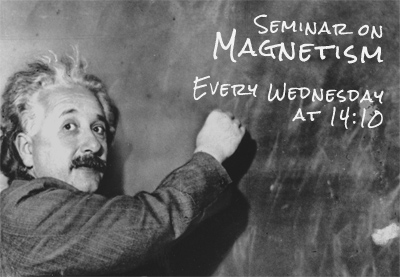Seminar on Magnetism
Group of Magnetism at the Department of Condensed Matter Physics
of Charles University and MGML has a pleasure to invite you to attend the joint seminar
on 26th March 2025 at 14:10
at Faculty of Mathematics and Physics of Charles University, Ke Karlovu 5, 121 16 Praha 2
Lecture room F2
Andrej Kancko
DCMP, Faculty of Mathematics and Physics, Charles University, Ke Karlovu 5, 121 16 Prague 2
Glass or Liquid? Untangling the Quantum Fate of Pyrochlore Spins in real materials
Andrej Kancko » Glass or Liquid? Untangling the Quantum Fate of Pyrochlore Spins in real materials
DCMP, Faculty of Mathematics and Physics, Charles University, Ke Karlovu 5, 121 16 Prague 2
Online link: cesnet.zoom.us Ask R. Colman for password.
Location: Lecture room F2, first floor - Ke Karlovu 5, 12116 Praha 2
The S = ½ Heisenberg pyrochlore antiferromagnet is a notoriously complex quantum system, the true ground-state of which remains an unresolved problem. The theoretical ground-state predictions are strongly method-dependent and vary from dimer singlet phases, spin-liquids with short-range correlations to chiral spin liquids. Very few model materials exist to complement and confirm these predictions and ideal realisations of this system are still missing.
The NaAM2F7 pyrochlore fluorides (A = Sr2+, Ca2+, Cd2+ and M = transition metal 2+ ion) [1] are a family of near-ideal model materials but suffer from a small magnetic-bond-disorder due to random mixing between Na+ and A2+ ions on the pyrochlore A-site. The previous reports of M = Co2+ members of this family, NaCaCo2F7 and NaSrCo2F7 (both Seff = ½) have shown strong antiferromagnetic interactions (θCW ≈ -140 K) [2,3] with no magnetic order, instead freezing into spin-glass ground-states with XY-type anisotropy at low temperatures (Tf ≤ 3K). However, no ideal S = ½ realisations of this family have yet been studied except for the first successful synthesis report of the S = ½ Cu2+-based pyrochlore, NaCdCu2F7. [4]
We report a thorough magnetic-ground-state characterisation (thermodynamic measurements, ac-susceptibility, [high-field] dc-magnetisation, 23Na-NMR, and μSR) of the two new A = Cd additions to this pyrochlore fluoride family, the random-spin-singlet quantum spin liquid candidate NaCdCu2F7 (S = ½) and the spin-glass NaCdCo2F7 (Seff = ½). While these isostructural, magnetically-frustrated compounds share apparent similarities such as employing the low-spin-state (effective)-spin-½ magnetic ions (Cu2+ and Co2+) on the frustrated pyrochlore lattice, or showing similar exchange interaction strengths (θCW ≈ -100 K), they seem to show very different magnetic-ground-state properties. While NaCdCo2F7 undergoes a spin-freezing transition at Tf = 4 K [5], NaCdCu2F7 shows continuous dynamics with no signs of any magnetic transition down to 50 mK. In addition, NaCdCu2F7 shows a power-law scaling of low-temperature susceptibility χ(T) ~ T -γ (with γ = 0.68), as well as data collapse of magnetic specific heat (μ0H)γ Cmag/T vs. T/μ0H and isothermal magnetization MTγ-1 vs. μ0H/T. This suggests random-spin-singlet physics stemming from defect spins with a power-law distribution of exchange energies P[J] ~ T -γ. [6]
References
[1] A. Kancko et al., ArXiV, arXiv:2411.11579, s. 1–14. (2024).
[2] J. W. Krizan and R. J. Cava, NaCaCo2F7: A single-crystal high-temperature pyrochlore antiferromagnet, Phys. Rev. B 89, 214401 (2014).
[3] J. W. Krizan and R. J. Cava, NaSrCo2F7, a Co2+ pyrochlore antiferromagnet, J. Phys. Condens. Matter 27, 296002 (2015).
[4] R. Hansler and W. Rudorff, A2B2F7-Verbindungen mit Pyrochlor- und Weberitstruktur, Z. Naturforsch. B 1306 (1967).
[5] A. Kancko, G. Giester, and R. H. Colman, Structural and spin-glass properties of single crystal Jeff = ½ pyrochlore antiferromagnet NaCdCo2F7: correlating Tf with magnetic-bond-disorder, Phys. Scr. 98, 075947 (2023).
[6] I. Kimchi, J. P. Sheckelton, T. M. McQueen, and P. A. Lee, Scaling and data collapse from local moments in frustrated disordered quantum spin systems, Nat. Commun. 9, 1 (2018).


